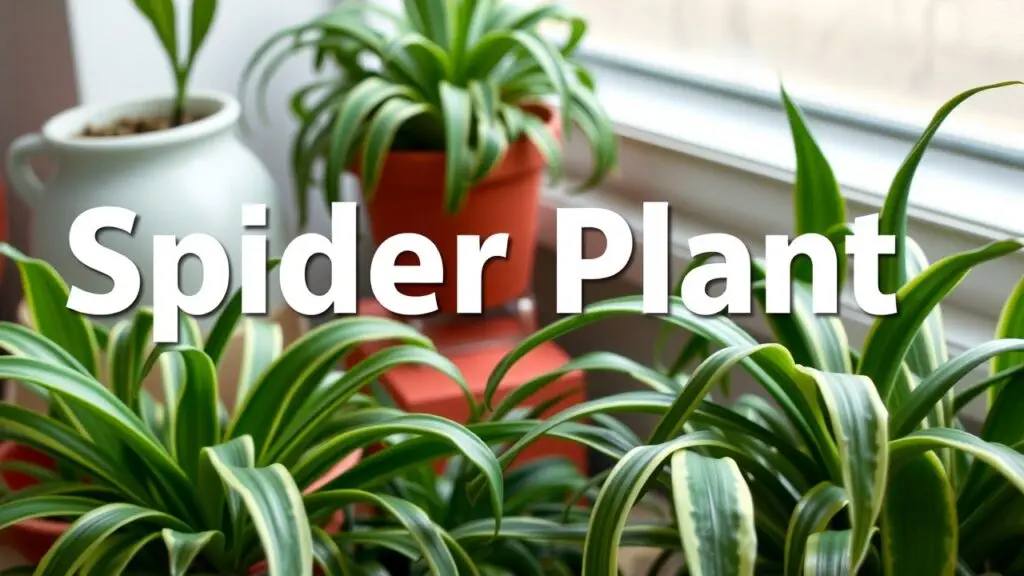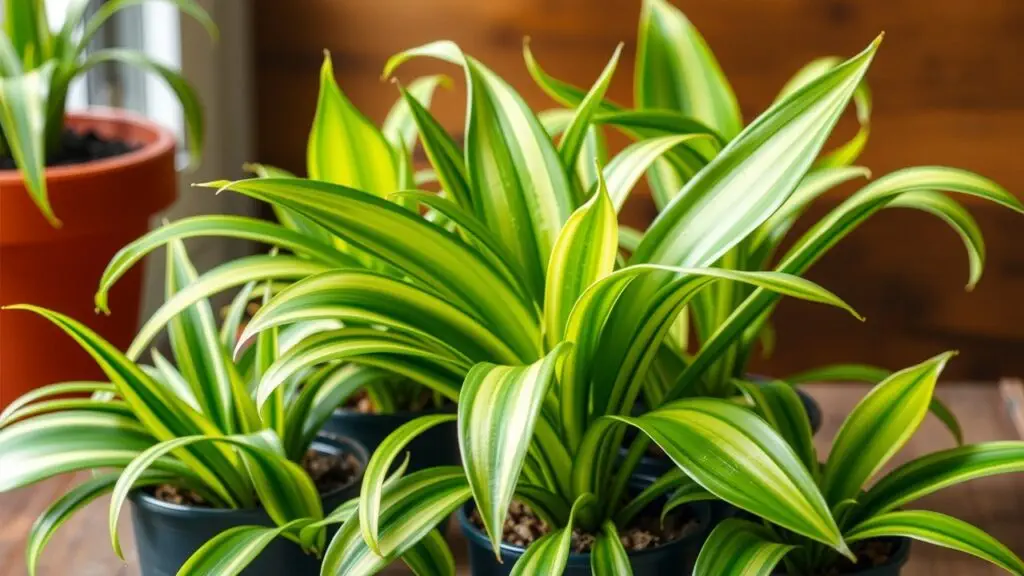Types of spider plants are diverse, including the popular Chlorophytum comosum, offering many choices for plant lovers. This guide covers various spider plant varieties, care instructions, and propagation techniques.
What Are Spider Plants (Chlorophytum comosum)?

Spider plants, or Chlorophytum comosum, are super popular houseplants. People love them for their pretty look and easy care. They are great for anyone, whether you’re just starting or a seasoned gardener. These plants have long, strap-shaped leaves that can reach 12 inches long. Most are a vibrant green, but some have cool white or yellow stripes.
One really cool thing about spider plants is how they clean the air. They can take away bad stuff like formaldehyde and xylene, making the air in your home healthier. Plus, spider plants make little offshoots called “pups.” You can easily grow new plants from these pups!
So, spider plants are not only nice to look at but also help make the air in our homes better.
Why Learn About Different Types of Spider Plants?
Knowing the different types of spider plants is helpful for several reasons. First, each type has its own unique looks that can spice up your home. Some have fancy patterns or colors on their leaves that match different styles of decoration.
Also, understanding these plant varieties helps you use space better in your home or garden. Certain types of spider plants do better in specific conditions. Picking the right kind ensures you create a comfy home for each plant.
Different kinds also have different care needs. Some need more sunlight while others like it shady or need more humidity like in tropical areas. By learning about these differences, you can care for your spider plants well and enjoy their beauty around your space!
Popular Varieties of Spider Plants
Chlorophytum comosum ‘Variegatum’ (Striped Spider Plant)
The Striped Spider Plant, or Chlorophytum comosum ‘Variegatum’, has beautiful green leaves with creamy white edges. This plant likes to trail, which makes it perfect for hanging baskets or shelves. Its cascading plantlets, called “spiderettes,” look great and add charm to any space. The variegated spider plant is not just pretty; it also grows well in many indoor conditions.
Chlorophytum comosum ‘Bonnie’ (Curly Spider Plant)
The Curly Spider Plant, known as Chlorophytum comosum ‘Bonnie’, is small and has fun, curly green leaves. It brings a cheerful vibe to your room. This plant works best on windowsills or in tight spaces where you need something compact. It’s also super easy to take care of, making it a favorite among new plant owners who want to enjoy indoor gardening.
Chlorophytum comosum ‘Green Orange’ (Vibrant Color Variety)
If you’re looking for a splash of color, the Green Orange variety is a great pick. Its bright green leaves stand out with orange-yellow stems and stripes. This eye-catching plant not only makes your home look lively but also helps clean the air. It’s low-maintenance too, so you don’t have to worry much about taking care of it.
Chlorophytum comosum ‘Mandaianum’ (Narrow-Leaved Type)
Chlorophytum comosum ‘Mandaianum’, also called the Narrow-Leaved Type, features slim, grass-like leaves. This plant gives a nice, simple look to any room. It grows upright, which is different from other spider plants. It’s still easy to care for like the other varieties, making it a smart choice for anyone who loves indoor plants.
These popular varieties show just a few options in the world of spider plants. Each one brings something special and beautiful into your home while being easy to care for. They’re great choices for beginners and experienced gardeners alike!
Rare and Unique Cultivars
Rare Varieties You Should Know About:
Spider plants are cool, and some rare types really stand out! If you’re a plant lover, here are some neat varieties you should think about adding to your collection.
- Chlorophytum comosum Ocean: This plant is super pretty with wavy leaves that look like ocean waves. The ‘Ocean’ spider plant has creamy white edges that pop against its dark green center. It loves bright, indirect light and needs well-draining soil. With its amazing look, it’s a hit among collectors who want to spice up their indoor spaces.
- Chlorophytum comosum ‘Vittatum’: The Vittatum spider plant is easy to spot. It has long, arching leaves with striking white stripes down the middle. This popular variety brings a touch of class and works well in many lighting situations. It’s perfect for both new gardeners and experienced ones. Just remember, it likes moderate light and regular watering but not too much water!
- Milky Way Spider Plant: This variety stands out with its leaves that have unique patterns, kinda like stars in the sky. The Milky Way spider plant is eye-catching and can make any room brighter. Like its cousins, it enjoys bright indirect sunlight. Water it when the top inch of soil feels dry.
- Hawaiian Spider Plant: If you’re after something tropical, the Hawaiian spider plant is your go-to! It has lush green leaves with hints of yellow or cream along the edges. This vibrant look brings a taste of warm climates right into your home. This cultivar also enjoys bright indirect light and likes to be kept moist.
Each of these rare cultivars is special in its own way. Understanding what makes them unique helps you appreciate their beauty even more! Plus, taking care of them properly ensures they thrive in your home or garden. So, which one will you choose for your collection?
How Do I Identify My Own Type Of Spider Plant?
Identifying your spider plant can be fun and easy. There are many types of spider plants, known as Chlorophytum comosum. Each one has its own traits. This guide will help you figure out which type you have by looking at the leaves, colors, size, and how it grows.
Leaf Shape Identification
First, check the shape of your spider plant’s leaves. Are they wide and strap-like, or are they narrow like grass? Here are a few examples:
- The ‘Bonnie’ variety has curly leaves.
- The ‘Mandaianum’ type has straighter leaves that stand up tall.
By paying attention to leaf shape, you can start to see which kind of spider plant you might own.
Coloration Patterns
Next, look closely at the colors on the leaves. Different types show off different patterns:
- Variegatum: This one has creamy white edges on its green leaves.
- Green Orange: You’ll notice bright orange-yellow stems that pop against green leaves.
These colorful patterns not only make the plant look nice but also help with identification.
Size Traits
The size of your spider plant matters too. Some plants are small and compact, while others grow larger:
- ‘Bonnie’ is great for tiny spots because it’s compact.
- Bigger varieties need more space to stretch out and grow well.
Knowing the size helps you pick the right spot for your spider plant.
Growth Habits
Take a moment to observe how your spider plant grows. Does it produce many “spiderettes” (little offshoots) that hang down? Or does it grow straight up with fewer babies?
For example:
- Trailing plants look lovely in hanging baskets where they can drop down.
Recognizing these growth habits makes it easier to know which type you’re caring for.
Spider Plant Care: A Comprehensive Guide
Light Requirements
Spider plants like bright, indirect light. They can also grow in lower light conditions. These houseplants are flexible and do best with a mix of sun and shade. Too much direct sunlight can burn their leaves, while too little light might slow their growth. The best spot for a spider plant is near a window that gets filtered light or in a well-lit room.
Different spider plant varieties may need different light levels. Variegated spider plants, for example, need more light than the solid green ones to keep their colors bright. Besides looking good, spider plants are also air-purifying plants. They help clean your indoor air by filtering out toxins.
Watering
Watering is super important for your spider plant’s health. These easy houseplants like to dry out between waterings. Overwatering can lead to root rot, and not enough water causes brown tips on the leaves. Usually, watering once a week or every two weeks works well during spring and summer. In winter, cut back on watering since the plant grows slower.
To check if your spider plant needs water, stick your finger about an inch into the soil. If it feels dry there, it’s time for a drink! Keeping moisture levels steady helps these common houseplants stay healthy and happy.
Soil and Potting
Getting the right potting mix is key to caring for your spider plant. A well-draining mix works best. Look for potting blends made for indoor plants that include peat moss and perlite to help with air flow.
When you repot your spider plant babies (the small offshoots), choose pots that are one size bigger than their current pots. This gives them room to grow without drowning in extra soil. Variegated leaves also need good soil to get the nutrients they need when you pot them up again.
Fertilizer
Fertilizing your spider plants helps them grow strong and healthy. Use a balanced liquid fertilizer diluted to half strength during spring and summer when they are growing fast. This encourages lush foliage without risking nutrient burn, which often happens if you use full-strength fertilizers too often.
Skip fertilizing in fall and winter when the growth slows down unless you’re using special fertilizers meant for that time.
Temperature and Humidity
Spider plants like warm temperatures between 65°F and 75°F (18°C – 24°C). They can handle cooler spots down to 50°F (10°C). Keeping temperatures stable helps prevent stress on these tough indoor plants.
For humidity, they prefer moderate levels but can adjust to drier homes during winter when heaters are on. If you notice leaf tips turning brown even with proper watering, try misting them or using a humidifier nearby.
Common Problems and Solutions
Even though they are tough houseplants, spider plants can have some issues like yellowing leaves from overwatering or not enough light fixing these problems is usually easy! Sometimes pests like aphids or mealybugs may show up; checking your plants regularly can help catch these before they spread too much.
For diseases like root rot from too much moisture in the pot just make sure drainage holes stay clear so roots can breathe! With good care tips based on each varietys needs including those rare types you’ll have healthy specimens thriving indoors all year long!
Spider Plant Propagation

Propagating from Plantlets (Spiderettes)
One of the easiest ways to propagate spider plants is through their plantlets, known as spiderettes or pups. These small offshoots grow from the mother spider plant and can be easily separated to create new plants. This method is popular among houseplant lovers because it allows for quick multiplication without needing seeds.
Step-by-Step Guide for Propagation
To propagate your spider plant using its pups, just follow these simple steps:
- Gather Materials: Get some sharp scissors or shears to make clean cuts.
- Identify Healthy Spiderettes: Look for healthy, green spiderettes on your mother plant that are at least a few inches long.
- Cut the Spiderette: Carefully cut the pup close to where it attaches to the main stem of the mother plant.
- Place in Water or Soil: You can either put the cutting in water or directly into potting soil:
- If using water, only submerge the base of the cutting; roots will grow within a few weeks.
- If planting directly in soil, keep it moist but not soggy.
This straightforward process makes propagation easy, even for beginners.
Other Propagation Methods
While using spiderettes is common, there are other methods you might try if you’re feeling adventurous.
Division
Division means separating larger clumps of your spider plant during repotting time in spring or early summer:
- Remove the entire root ball from its pot carefully.
- Gently pull apart smaller plants from larger ones while ensuring each has some roots attached.
This method helps refresh older plants and gives you more individual specimens.
Seeds
Though less common and often yielding unpredictable results regarding true-to-type plants, seed propagation can be tried:
- Collect seeds after flowering occurs on your spider plant.
- Sow them in a suitable seed starting mix and keep them moist until germination happens.
This method needs patience and may take longer than other techniques.
Tips for Successful Propagation
For great growth during propagation:
- Make sure to have proper light; bright indirect sunlight works best for healthy development.
- Keep humidity around newly propagated plants by covering them with plastic bags temporarily, if needed this helps rooting success.
By following these guidelines, you’ll find propagating different types of spider plants fun and rewarding!
Choosing the Right Spider Plant for You
Matching Spider Plants to Your Home
When you pick a spider plant, think about how it will fit in your home. There are many types of spider plants that can grow well indoors. The classic green spider plant is one of the most popular houseplants because it’s easy to take care of. It grows well in different lighting, so it’s great for indoor spaces.
If you want something eye-catching, you might like the variegated versions. For example, ‘Vittatum’ or ‘Bonnie’ have special leaf patterns that make them fun to look at. These hanging plants are also great for shelves or hanging baskets since their long leaves can drape down beautifully.
Most spider plants are low-maintenance houseplants. They need only moderate watering and prefer indirect sunlight. This makes them perfect if you’re a beginner or just want a pretty and easy-to-care-for plant.
Beginner-Friendly Spider Plants
For new plant owners, some spider plant varieties are especially easy to grow. The green spider plant is a top choice because it’s tough and forgiving if you make mistakes while caring for it.
Another good option is the Bonnie spider plant. Its curly leaves add a fun touch, and it’s small enough to fit in tight spots while still being charming.
Variegated options like ‘Vittatum’ are also simple to care for. These plants have lovely white stripes on their leaves and share similar needs with other common spider plants, making them just as easy to look after.
Advanced Spider Plant Choices
If you’re an experienced gardener, you might enjoy trying rare or unusual cultivars of spider plants. One exciting choice is Chlorophytum comosum ‘Ocean.’ This variety has unique blue-green leaves with creamy edges perfect for any collection!
Another interesting option is Chlorophytum comosum ‘Vittatum.’ It features striking white stripes running through its green leaves. This one requires a bit more attention than regular types but rewards you with its beauty.
Lastly, consider the Milky Way spider plant (Chlorophytum comosum’ Milky Way). It has speckled leaves that look like a starry night sky great for collectors who love unique indoor plants!
Frequently Asked Questions (FAQs)
What are the common names for spider plants?
Spider plants are often called airplane plants or ribbon plants. These names highlight their long, strap-shaped leaves.
Do spider plants produce flowers?
Yes, spider plants can bloom. They produce small, star-shaped white flowers. These blooms appear on long stalks and can create a lovely display.
How do I care for spider plant offsets?
Spider plant offsets, or spiderettes, grow from the mother plant. Allow them to develop roots before cutting them off. Then, plant them in moist soil for growth.
Are there different types of leaves on spider plants?
Yes, spider plants have various leaf types. You may see solid green leaves or ones with variegation. Common variations include white and cream-striped leaves.
Why are spider plants good for indoor spaces?
Spider plants help purify the air by removing toxins. They rank among the best houseplants for improving indoor air quality.
Can I grow spider plants in hanging baskets?
Absolutely! Spider plants look great in hanging baskets. Their trailing nature makes them perfect for this type of container gardening.
Are spider plants low-maintenance?
Yes, they are low-maintenance houseplants. They require minimal watering and thrive in various light conditions.
Where can I find rare types of spider plants?
You may discover rare varieties at specialized nurseries or online plant shops. Look for unique cultivars like the Milky Way Spider Plant.
How do I tell if my spider plant is healthy?
Healthy spider plants show vibrant green foliage and no brown tips on leaves. Regular watering and appropriate light help maintain their health.
Additional Types of Spider Plants
- Green Spider Plant: Classic variety known for solid green leaves.
- Curly Spider Plant: Features unique curly foliage, adding charm to decor.
- Ribbon Plant: Another name for spider plants due to their leaf shape.
- Mother Spider Plant: The main plant that produces offsets or pups.
- Spiderette: A small offshoot that grows from the mother plant.
- Hanging Plants: Ideal for displaying trailing varieties in baskets.
- Inexpensive Plants: Spider plants are affordable and easy to find.
- Common Houseplants: Popular among indoor gardeners due to their adaptability.
- Foliage Plants: Valued for their attractive greenery in home decor.
- Air Purifying Plants: Effective at improving indoor air quality.
- Star-Shaped Flowers: Unique blooms add interest when they appear.
- Black Seeds: Produced after flowering; may be used for propagation.
- Ground Cover Plant: Can spread out if planted directly in gardens.
Related Topics
- Types of spider plants
- Types of houseplants
- Types of air-purifying plants
- Types of hanging plants
- Types of indoor plants
- Types of low-maintenance plants
- Types of variegated plants
- Types of foliage plants
- Types of ground cover plants
- Types of beginner-friendly plants



Types of Spider Plants: A Complete Guide to Varieties, Care, and Propagation